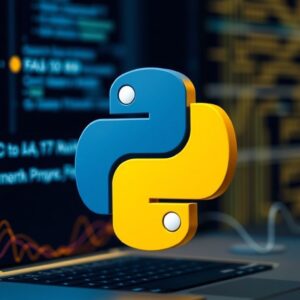Cloud Computing using AWS
Original price was: ₹3,999.00.₹2,999.00Current price is: ₹2,999.00.
Description
This course is designed for beginning Linux & Cloud Administration who are interested in learning essential of Linux administration and Cloud working skills. The class provides-hands-on training to effectively use Linux OS with AWS Cloud environment. In addition, administrators will learn how to configure servers like http and security of them.
Prerequisites:
Basic Knowledge of computers.
Key Learning Outcomes:
- You will be able to configure and administrate Linux OS & AWS Cloud Environment.
- You will be able to manage, configure and administrate cloud network
- Can know more advance things about Cloud
Targeted Audience
- Students who want to get selected in Top-Tier IT Companies like TCS, Infosys , Microsoft , Samsung , Google , Amazon , Facebook , Wipro and all leading MNC’s of the world .
- B.Tech/MCA/BCA/B.Sc IT/M.Tech Students/Working Professionals from Corporate.
Test & Evaluation
- During the program, the participants will have to take all assignments given to them for better learning.
- At the end of the program, a final assessment will be conducted.
Certification
- All successful participants will be provided with a certificate of completion.
- Students who do not complete the course / leave it midway will not be awarded any certificate.
Duration
100 hours (40 hours ONLINE LIVE sessions + 60 Hours of assignment)
Delivery Mode:
Online Live Instructor led learning.
Linux Basic
• Access the command line
• Log in to a Linux system and run simple commands using the shell.
• Manage files from the command line
• Copy, move, create, delete, and organize files from the bash shell prompt.
• Get help in Red Hat Enterprise Linux
Linux Administration, Server and Security
• Create, view, and edit text files
• Create, view, and edit text files from command output or in an editor.
• Manage local Linux users and groups
• Manage local Linux users and groups, and administer local password policies.
• Control access to files with Linux file system permissions
• Set Linux file system permissions on files and interpret the security effects of different permission settings.
• Monitor and manage Linux processes
• Obtain information about the system, and control processes running on it.
• Control services and daemons
• Control and monitor network services and system daemons using system
• Configure and secure OpenSSH service
• Access and provide access to the command line on remote systems securely using OpenSSH
• Analyze and store logs
• Locate and accurately interpret relevant system log files for troubleshooting purposes.
• Manage Red Hat Enterprise Linux networking
• Configure basic IPv4 networking on Red Hat Enterprise Linux systems.
• Archive and copy files between systems
• Archive files and copy them from one system to another.
• Install and update software packages
• Download, install, update, and manage software packages from Red Hat and yum package repositories.
• Access Linux file systems
• Access and inspect existing file systems on a Red Hat Enterprise Linux system
• Use virtualized systems
• Create and use Red Hat Enterprise Linux virtual machines with KVM and libvirt.
• Automate installation with Kickstart
• Automate the installation of Red Hat Enterprise Linux systems with Kickstart.
• Use regular expressions with grep.
• Write regular expressions that, when partnered with grep, will allow you to quickly isolate or locate content within text files.
• Create and Edit text files with vim
• Introduce the vim text editor, with which you can open, edit, and save text files.
• Schedule future Linux tasks.
• Schedule tasks to automatically execute in the future.
• Manage priority of Linux processes.
• Influence the relative priorities at which Linux processes run.
• Control access to files with access control lists (ACL)
• Manage file security using POSIX access control lists.
• Manage SELinux security.
• Manage the Security Enhanced Linux (SELinux) behavior of a system to keep it secure in case of a network service compromise.
• Connect to network-defined users and groups.
• Configure systems to use central identity management services.
• Add disks, partitions, and file systems to a Linux system.
• Manage simple partitions and file systems.
• Manage logical volume management (LVM) storage.
• Manage logical volumes from the command line.
• Access networked attached storage with network file system (NFS).
• Access (secure) NFS shares.
• Access networked storage with SMB.
• Use autofs and the command line to mount and unmount SMB file Systems.
• Control and troubleshoot the Red Hat Enterprise Linux boot process.
• Limit network communication with firewall.
• Configure a basic firewall.
Introduction to Cloud Computing
• What is the cloud?
• History of Cloud Computing
• How Cloud Computing Works?
• Advantages & Disadvantages
Cloud Pyramid
• Applications for Businesses
• Cloud Service Providers
• Cloud Computing Architecture
• Cloud Computing Terminology
• Communication-as-a-Service (CaaS)
• Infrastructure-as-a-Service (IaaS)
• Monitoring-as-a-Service (MaaS)
• Software-as-a-Service (SaaS)
• Platform-as-a-Service (PaaS)
• Types, Priced and open-source products in the market.
• Overview of Public Cloud vendors
• Overview of Private cloud products
Public Cloud Services – using Amazon Cloud
• Introduction to Amazon AWS cloud – Pricing, Regions Availability Zones, Types of instances
• Overview of different services of AWS.
• Consuming EC2 Instance Service from AWS
• Creating Linux and Windows Instances from the available AMIs connecting and remote control from the laptop
• Consuming EBS block storage service from AWS – Adding volumes to Instances Taking snapshots, creating volumes from snapshots, attaching volumes to running instances.
• Using Elastic IP service –Assigning Public IP addresses and connecting from the internet.
• Installing additional software components on the instances.
• Automating installations and tasks at the booting time of an instance
• Using the Load Balancers for load distribution (ELB)
• Installing command line tools
• Using cloud watch service
• Creating own AMIs
• Virtual Private Cloud – Public and Private Network Scenarios
• Using AWS S3 service, CORS, Glacier
• Creating a MySQL database using RDS service
• IAM –Identity Access Management, IAM Policies
• Taking backups using command line tools.
• Understand AWS management tools, including Auto Scaling
• EFS, SNS (Simple Notification System)
• Kinesis
• AWS Serverless: AWS Lambda
• ElastiCache
• AWS Global Accelerator
• CDN (Content Delivery Network)
• WAF, KMS
• Snow Ball, Storage Gateway
• Data Sync, Database Migration
• Mail Services
You can also give us a call on Mobile +91-9312889010





